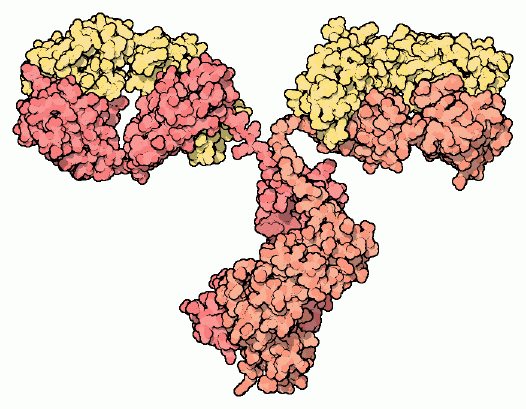|
Inhaltsübersicht | Nanomaschinen | Moleküle | Programme | Kurse | Fun | Links |
||
| > |
Antibodies
Molecular Watchdogs
Antibodies are our molecular watchdogs, waiting and watching for viruses, bacteria and other unwelcome visitors. Antibodies circulate in the blood, scrutinizing every object that they touch. When they find an unfamiliar, foreign object, they bind tightly to its surface. In the case of viruses, like rhinovirus or poliovirus presented last month in the Molecule of the Month, a coating of bound antibodies may be enough to block infection. Antibodies alone, however, are no match for bacteria. When antibodies bind to a bacterial surface, they act as markers alerting the other powerful defensive mechanisms available in the immune system.Getting a Grip
Antibodies, and many of the other molecules used in the immune system, have a distinctive shape. Typically, they are composed of several flexible arms with binding sites at the end of each one. This make perfect sense: since antibodies do not know in advance what attackers they might be fighting, they keep their options open. The flexible arms allow the binding sites to work together, grabbing with both arms onto targets with different overall shapes. The antibody shown here, from PDB entry 1igt, has two binding sites, at the tips of the two arms extending right and left at the top. Notice the thin, flexible chains that connect these arms to the central domain at the bottom. Some antibodies have longer flexible linkers connecting the arms together, allowing them even more latitude when finding purchase on a surface. Other antibodies have four or ten binding sites, so each contact can be weaker and still allow the whole antibody to bind firmly.Power in Numbers
Your blood contains upwards of 100,000,000 different types of antibodies. Each type binds to a different target molecule. Remarkably, all of these antibodies are created before they ever see a virus or bacterium. You don't make a special antibody when a virus or bacterium infects your body. Instead, all of your antibodies are pre-fabricated, lying in wait until a virus or bacterium attacks. There are so many different kinds of antibodies that one or two are bound to be the right ones to fight the infection.
This amazingly huge collection of antibodies is created by recombination of genes in lymphocytes, the blood cells that make antibodies. Each lymphocyte creates a different type of antibody, based on how it has recombined its antibody genes. When an antibody encounters a virus or bacterium, the appropriate lymphocytes will multiply, flooding the blood with the particular antibodies needed to battle the invader. These lymphocytes may also make small adjustments on the antibodies they produce, tailoring their antibodies to bind more tightly and more specifically.
Antibody Structure
Antibodies are composed of four chains, two long heavy chains (colored red and orange) and two shorter light chains (yellow). The specific binding site is found at the tips of the two arms, in a pocket formed between the light and heavy chain. The binding site is composed of several loops in the protein chain that have very different lengths and amino acid composition. Differences in these "hypervariable loops" form the many types of pockets in different antibodies, each of which bind specifically to a different target. The rest of the antibody--the rest of the arms and the large constant domain that ties the two arms together--is relatively uniform in structure, providing a convenient handle when antibodies interact with the rest of the immune system.Next: Attack from Many Angles
Last changed by: A.Honegger,